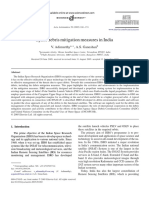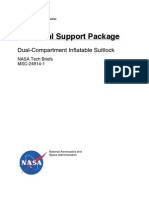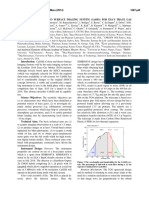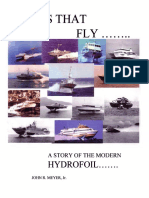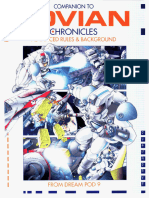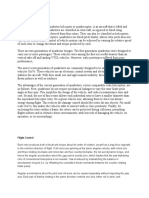0 ratings0% found this document useful (0 votes)
16 viewsMulti-Mission Space Exploration Vehicle6008
Multi-Mission Space Exploration Vehicle6008
Uploaded by
Junior MirandaThis document discusses the Multi-Mission Space Exploration Vehicle (MMSEV), which is designed to serve as an EVA and robotics work system for multiple destinations like the Moon. The MMSEV uses a modular design with a small, high-function core cabin that can be outfitted with different mobility and work packages. This allows it to be extended to multiple missions and applications in a cost-effective way. Key features of the MMSEV include providing a shirtsleeve environment for habitation and observations while allowing suited astronauts to rapidly conduct EVAs. Prototypes have been developed and tested to demonstrate the concept.
Copyright:
© All Rights Reserved
Available Formats
Download as PDF, TXT or read online from Scribd
Multi-Mission Space Exploration Vehicle6008
Multi-Mission Space Exploration Vehicle6008
Uploaded by
Junior Miranda0 ratings0% found this document useful (0 votes)
16 views1 pageThis document discusses the Multi-Mission Space Exploration Vehicle (MMSEV), which is designed to serve as an EVA and robotics work system for multiple destinations like the Moon. The MMSEV uses a modular design with a small, high-function core cabin that can be outfitted with different mobility and work packages. This allows it to be extended to multiple missions and applications in a cost-effective way. Key features of the MMSEV include providing a shirtsleeve environment for habitation and observations while allowing suited astronauts to rapidly conduct EVAs. Prototypes have been developed and tested to demonstrate the concept.
Original Description:
texts about space tech
Original Title
multi-mission Space Exploration Vehicle6008
Copyright
© © All Rights Reserved
Available Formats
PDF, TXT or read online from Scribd
Share this document
Did you find this document useful?
Is this content inappropriate?
This document discusses the Multi-Mission Space Exploration Vehicle (MMSEV), which is designed to serve as an EVA and robotics work system for multiple destinations like the Moon. The MMSEV uses a modular design with a small, high-function core cabin that can be outfitted with different mobility and work packages. This allows it to be extended to multiple missions and applications in a cost-effective way. Key features of the MMSEV include providing a shirtsleeve environment for habitation and observations while allowing suited astronauts to rapidly conduct EVAs. Prototypes have been developed and tested to demonstrate the concept.
Copyright:
© All Rights Reserved
Available Formats
Download as PDF, TXT or read online from Scribd
Download as pdf or txt
0 ratings0% found this document useful (0 votes)
16 views1 pageMulti-Mission Space Exploration Vehicle6008
Multi-Mission Space Exploration Vehicle6008
Uploaded by
Junior MirandaThis document discusses the Multi-Mission Space Exploration Vehicle (MMSEV), which is designed to serve as an EVA and robotics work system for multiple destinations like the Moon. The MMSEV uses a modular design with a small, high-function core cabin that can be outfitted with different mobility and work packages. This allows it to be extended to multiple missions and applications in a cost-effective way. Key features of the MMSEV include providing a shirtsleeve environment for habitation and observations while allowing suited astronauts to rapidly conduct EVAs. Prototypes have been developed and tested to demonstrate the concept.
Copyright:
© All Rights Reserved
Available Formats
Download as PDF, TXT or read online from Scribd
Download as pdf or txt
You are on page 1of 1
Workshop on Golden Spike Human Lunar Expeditions (2013) 6008.
MULTI-MISSION SPACE EXPLORATION VEHICLE (MMSEV): AN EVA AND ROBOTICS WORK-
SYSTEM FOR MULTIPLE DESTINATIONS. A. F. J. Abercromby1, S. P. Chappell1, and M. L. Gernhardt2,
1
Wyle Science, Technology, and Engineering, Houston, TX 77058, USA, (andrew.abercromby-1@nasa.gov),
2
National Aeronautics and Space Administration, NASA Johnson Space Center, Houston, TX 77058, USA.
Vision: The Multi-Mission Space Exploration Ve- MMSEV Features: MMSEVs optimize astronaut
hicle (MMSEV) is an EVA and robotics work system safety and performance during exploration by combin-
optimized at the level of astronaut performance and ing a comfortable shirtsleeve environment for habita-
safety rather than at the subsystem level with key fea- tion, gross translations, and geological observations,
tures including: EVA-equivalent visibility, low- with the ability to rapidly place suited astronauts out-
overhead EVA, and protection against solar particle side the vehicle to take full advantage of the percep-
events. The MMSEV uses a modular approach with a tion, judgment, and dexterity of EVA astronauts. Low-
low-volume, high-function core cabin that is kitted with overhead EVA capability is achieved via “step-in”
different mobility and work packages making it exten- space suits and suit ports, which allow crewmembers to
sible to multiple mission destinations and applications. egress or ingress the vehicle in 15 minutes or less with
Originally developed as a small pressurized rover minimal consumables or energy usage [5], improving
for human lunar exploration missions, MMSEV proto- productivity and ensuring rapid EVA ingress and
types have been developed for multiple destinations egress to and from the shelter of the MMSEV in re-
and applications using the same core cabin design out- sponse to solar particle events, suit malfunctions, med-
fitted differently for each case. A small multi-center ical emergencies, or cabin depressurization. Compared
team rapidly designed, built, and tested two prototype with unpressurized astronaut mobility systems, this
planetary MMSEVs from 2007–2010 [1-3]. A third combination of features could more than double the
MMSEV prototype incorporates a cabin module modi- productivity of human exploration while requiring less
fied from the planetary MMSEVs and a modular reac- than half the suited crew time and eliminating the over-
tion control system sled designed for free-flying micro- head of returning to a habitat at the end of each day [1].
gravity missions to ISS, satellite servicing, or near- MMSEVs are envisioned as relatively small, sim-
Earth asteroids [4]. A fourth prototype is being devel- ple, and low cost vehicles combining elements of the
oped for use as a habitable airlock for an in-space habi- EVA suits’ life support systems, with additional con-
tat and a fifth was recently built and evaluated for use sumables tankage, cabin circulation fans, passive radia-
as a two-person or four-person lunar lander. tors, and an ice block heat sink for removal of cabin
Extensibility & Affordability: Multi-mission ap- avionics and crew metabolic heat loads that also dou-
plicability provides flexibility in response to changes in bles as radiation protection. MMSEV cabins (12 m3)
programmatic direction as well as potentially signifi- are sized to support 2 astronauts in a shirtsleeve envi-
cant cost reductions through utilization of an extensible ronment for up to 14 days of exploration, but provide
core design for multiple vehicles rather than develop- contingency support for 4 crewmembers for 24 hours;
ing optimal point solutions for every potential destina- testing of prototype MMSEVs in integrated mission
tion and mission application. The commercial offshore simulations has demonstrated that the MMSEV cabin
remotely operated vehicle (ROV) industry uses a design meets these requirements [2, 3].
common propulsion and telemetry bus outfitted for Exploring Beyond Apollo: A low-cost lunar ex-
different work applications as a much more cost effec- ploration architecture could begin with 1–2 day mis-
tive approach than developing entirely unique ROVs sions using a simple 2-person MMSEV-lander (esti-
for every different work application. NASA Air Force mated cabin wet mass: 2,207 kg) with EVAs performed
Cost Model (NAFCOM) estimates suggest significant on foot. Subsequent delivery of a single MMSEV-rover
cost savings are also achievable through the MMSEV (estimated 6,075 kg) would provide long-range explo-
project’s lean development approach of iterative design ration and 14-day habitation capability, representing
and build of increasingly flight-like prototype vehicles meaningful progression beyond Apollo.
combined with frequent and rigorous operational test- References: [1] Abercromby, A.F.J., et al,
ing at analog test sites and using high-fidelity integrat- NASA/TP 216136. 2010. [2] Abercromby,
ed software simulations. This testing provides high A.F.J., et al. Acta Astro, 2012. [3] Abercromby, A.F.J.,
confidence in design requirements for flight vehicles et al., NASA/TP 217360. 2012. [4] Abercromby, A.F.J.,
and enables informed decision making when trading et al., 43rd ICES. RATS. 2013. [5] Abercromby, A.F.J.,
multi-mission applicability against optimization for et al., 43rd ICES. Exploration Prebreathe. 2013
each destination and application.
You might also like
- A Multi Functional Two Chamber Airlock Node For A Common Habitat ArchitectureDocument22 pagesA Multi Functional Two Chamber Airlock Node For A Common Habitat ArchitecturebacondroppedNo ratings yet
- All About M KiiiDocument90 pagesAll About M Kiiisudhiruday31No ratings yet
- Weight and Balance Manual Rev12Document160 pagesWeight and Balance Manual Rev12Alex100% (1)
- Vehiculo Espacial SEV Concept FactSheetDocument4 pagesVehiculo Espacial SEV Concept FactSheetDilan Loaiza TapieroNo ratings yet
- 20160011570Document17 pages20160011570wujun.siNo ratings yet
- NASA Shuttle-C Heavy Lift Launch Vehicle 2009Document12 pagesNASA Shuttle-C Heavy Lift Launch Vehicle 2009Orion2015100% (3)
- The Multi-Mission Earth Entry Vehicle For Sample Return Missions - Past, Present, and Future Corliss, J.M., Kellas, S.R., Maddock, R.W.Document12 pagesThe Multi-Mission Earth Entry Vehicle For Sample Return Missions - Past, Present, and Future Corliss, J.M., Kellas, S.R., Maddock, R.W.pacoNo ratings yet
- 2009 Oct 24 NASA Ames PresentationDocument61 pages2009 Oct 24 NASA Ames Presentationyellowchickenhead3247No ratings yet
- Space Exploration VehicleDocument4 pagesSpace Exploration VehicleAviation/Space History LibraryNo ratings yet
- A Dual Thrust Axis Lander For Mars ExplorationDocument7 pagesA Dual Thrust Axis Lander For Mars ExplorationJuan Jose Mejia GonzalezNo ratings yet
- Editorial: Computational Intelligence For Space Systems and OperationsDocument3 pagesEditorial: Computational Intelligence For Space Systems and Operationslambanaveen123No ratings yet
- Sachithanandan Et Al. - 2023 - ECHO V2 Conceptual Design of A Modular InflatableDocument13 pagesSachithanandan Et Al. - 2023 - ECHO V2 Conceptual Design of A Modular InflatableMargarita RodriguezNo ratings yet
- CrewLogistics Lander for Common Hab ArchitectureDocument20 pagesCrewLogistics Lander for Common Hab ArchitectureJose Manuel CardenasNo ratings yet
- Exploration Lessons From The International Space StationDocument4 pagesExploration Lessons From The International Space StationWalt RamsNo ratings yet
- 2301.09059v1Document17 pages2301.09059v121CSE1016 Ketan KunkalikarNo ratings yet
- Space Station Key To The FutureDocument43 pagesSpace Station Key To The FutureBob AndrepontNo ratings yet
- Roadmapwkshp LessardDocument2 pagesRoadmapwkshp LessardIset LabNo ratings yet
- Zubrin 1991 PDFDocument27 pagesZubrin 1991 PDFsergiobaldiNo ratings yet
- Scramjet-Separation NASADocument12 pagesScramjet-Separation NASASREENATH S.SNo ratings yet
- Design Concept For A Minimal Volume Spacecraft Cabin To Serve As A Mars Ascent Vehicle Cabin and Other Alternative Pressurized Vehicle CabinsDocument7 pagesDesign Concept For A Minimal Volume Spacecraft Cabin To Serve As A Mars Ascent Vehicle Cabin and Other Alternative Pressurized Vehicle CabinsJp VillalonNo ratings yet
- Adimurthy 2006Document7 pagesAdimurthy 2006NikhilNo ratings yet
- 140637main ESAS 06Document150 pages140637main ESAS 06Adetoro Mal PascalNo ratings yet
- Analysis and Simulation of 3D Trajectory With Obstacle Avoidance of An Autonomous Underwater Vehicle For Optimum PerformanceDocument8 pagesAnalysis and Simulation of 3D Trajectory With Obstacle Avoidance of An Autonomous Underwater Vehicle For Optimum PerformanceMohamed ZayedNo ratings yet
- Mission_ Advanced Removal and Preservation(ARP)Document2 pagesMission_ Advanced Removal and Preservation(ARP)Arin BansalNo ratings yet
- Computer VisionDocument12 pagesComputer VisionPhani NNo ratings yet
- Mars Pathfinder Mission Operations Faster Better Cheaper On MarsDocument8 pagesMars Pathfinder Mission Operations Faster Better Cheaper On MarsSangwoo SukNo ratings yet
- NASA Facts Skylab Manned Orbital Scientific Space StationDocument4 pagesNASA Facts Skylab Manned Orbital Scientific Space StationBob Andrepont100% (1)
- 140639main ESAS 08 PDFDocument60 pages140639main ESAS 08 PDFEdwinHarNo ratings yet
- Leveraging Multiple Artificial Intelligence Techniques To Improve The Responsiveness in Operations Planning: ASPEN For Orbital ExpressDocument11 pagesLeveraging Multiple Artificial Intelligence Techniques To Improve The Responsiveness in Operations Planning: ASPEN For Orbital Expressjmoreno555No ratings yet
- Development of A Comprehensive Mission Operations System DesignedDocument19 pagesDevelopment of A Comprehensive Mission Operations System Designedjuan03192001No ratings yet
- Final Baseline PDFDocument282 pagesFinal Baseline PDFPranav CVNo ratings yet
- Nano SatelliteDocument15 pagesNano SatelliteDharni ShahNo ratings yet
- A Multi-Gravity Docking and Utilities Transfer System For A Common Habitat ArchitectureDocument17 pagesA Multi-Gravity Docking and Utilities Transfer System For A Common Habitat ArchitecturePierre BICABANo ratings yet
- 1-s2.0-S0094576524007227-mainDocument30 pages1-s2.0-S0094576524007227-mainhanpeng.eeNo ratings yet
- Technical Support Package: Dual-Compartment Inflatable SuitlockDocument14 pagesTechnical Support Package: Dual-Compartment Inflatable SuitlockJohn Melanathy IINo ratings yet
- IAC 19, A7,1,5, x49711Document15 pagesIAC 19, A7,1,5, x49711pacoNo ratings yet
- Search Planning of A UAV - UGV Team With Localization Uncertainty in A Subterranean EnvironmentDocument11 pagesSearch Planning of A UAV - UGV Team With Localization Uncertainty in A Subterranean EnvironmentamydewsylNo ratings yet
- 8028.pdf 15th Meeting of The Venus Exploration Analysis Group (VEXAG) (2017)Document1 page8028.pdf 15th Meeting of The Venus Exploration Analysis Group (VEXAG) (2017)Todor ToshkovNo ratings yet
- Chapter 7 IssDocument127 pagesChapter 7 IssSertug BaşarNo ratings yet
- (Mars One Scam) - An Independent Assessment of The Technical Feasibility of The Mars One Mission PlanDocument36 pages(Mars One Scam) - An Independent Assessment of The Technical Feasibility of The Mars One Mission PlanalvcardxNo ratings yet
- RossBurgon Thesis 2010Document279 pagesRossBurgon Thesis 2010Marianne MoralesNo ratings yet
- Scalable Trajectory Optimization Based On Bézier CurvesDocument10 pagesScalable Trajectory Optimization Based On Bézier CurvesAnonymous jGOFh2V0hNo ratings yet
- Hubble Facts The Hubble Space Telescope Second Servicing Mission (SM-2) Astronauts Prepare For SpacewalksDocument2 pagesHubble Facts The Hubble Space Telescope Second Servicing Mission (SM-2) Astronauts Prepare For SpacewalksBob AndrepontNo ratings yet
- NASA 140638main ESAS 07Document52 pagesNASA 140638main ESAS 07NASAdocumentsNo ratings yet
- Bergs Rud 2014Document11 pagesBergs Rud 2014Josue MarshallNo ratings yet
- Machine-Learning Space Applications On SmallSat Platforms With TeDocument8 pagesMachine-Learning Space Applications On SmallSat Platforms With Tej700159No ratings yet
- Modelcenter Lockheed Martin Space Case StudyDocument4 pagesModelcenter Lockheed Martin Space Case StudyzhouyeNo ratings yet
- Cost Effectiveoptionsforparachutetestingonhigh AltitudesoundingrocketDocument7 pagesCost Effectiveoptionsforparachutetestingonhigh AltitudesoundingrocketShakoor AkhtarNo ratings yet
- NASA 115869main Aerocapture FSDocument4 pagesNASA 115869main Aerocapture FSNASAdocumentsNo ratings yet
- CAVES ProgramDocument6 pagesCAVES ProgramKarthik RaoNo ratings yet
- 4 - Minimalist Jumping Robots For Celestial ExplorationDocument22 pages4 - Minimalist Jumping Robots For Celestial ExplorationjowdiverNo ratings yet
- Advpropulsion TD 2Document4 pagesAdvpropulsion TD 2shahriar shahzadaNo ratings yet
- Research Article: Vibration and Modal Analysis of Low Earth Orbit SatelliteDocument9 pagesResearch Article: Vibration and Modal Analysis of Low Earth Orbit SatelliteAmritansh RanjanNo ratings yet
- Cavaciuti-Davis-Heying ISAM 20220715Document26 pagesCavaciuti-Davis-Heying ISAM 20220715sghscribd2012No ratings yet
- Physics EE Stage OptimizationDocument7 pagesPhysics EE Stage Optimizationnb6tckkscvNo ratings yet
- NASA: 70891main FS-2004-02-84-LaRCDocument4 pagesNASA: 70891main FS-2004-02-84-LaRCNASAdocumentsNo ratings yet
- Rover Technology Development and Mission Infusion Beyond MERDocument11 pagesRover Technology Development and Mission Infusion Beyond MERHema AnilkumarNo ratings yet
- 333-2062-1-PBDocument11 pages333-2062-1-PBAbdulbaset JomaNo ratings yet
- Week01-Lab-Classes and ObjectsDocument4 pagesWeek01-Lab-Classes and ObjectsVarent LionelNo ratings yet
- A potential application of General Systems theory: KESTS, a unique transportation technology concept & implications (1994)From EverandA potential application of General Systems theory: KESTS, a unique transportation technology concept & implications (1994)No ratings yet
- Electric Pump-FedDocument9 pagesElectric Pump-FedJunior MirandaNo ratings yet
- Delta IVDocument4 pagesDelta IVJunior MirandaNo ratings yet
- Iran MissileDocument492 pagesIran MissileJunior MirandaNo ratings yet
- Luna 9Document7 pagesLuna 9Junior MirandaNo ratings yet
- 1067.pdf Eighth International Conference On Mars (2014) : Telescope Characteristics. A Trade-Off Exists BeDocument2 pages1067.pdf Eighth International Conference On Mars (2014) : Telescope Characteristics. A Trade-Off Exists BeJunior MirandaNo ratings yet
- NASA Earth-to-Orbit Engineering Design Challenges: Thermal Protection SystemsDocument75 pagesNASA Earth-to-Orbit Engineering Design Challenges: Thermal Protection SystemsJunior MirandaNo ratings yet
- Aiaa 2000-1042 of Conceptual Design of Early Venturestar Tmconfigurations M. K. LockwoodDocument14 pagesAiaa 2000-1042 of Conceptual Design of Early Venturestar Tmconfigurations M. K. LockwoodJunior MirandaNo ratings yet
- Mss 1483428Document2 pagesMss 1483428Junior MirandaNo ratings yet
- Mss I 07 17 004Document12 pagesMss I 07 17 004Junior MirandaNo ratings yet
- X 38 PM L - Pl3aDocument40 pagesX 38 PM L - Pl3aJunior MirandaNo ratings yet
- Embrapa Cecafe EvaristoDocument51 pagesEmbrapa Cecafe EvaristoJunior MirandaNo ratings yet
- Space Launch System (SLS) Mission Planner's Guide - ESD 30000 Baseline - 12apr17 106pp - 20170005323Document106 pagesSpace Launch System (SLS) Mission Planner's Guide - ESD 30000 Baseline - 12apr17 106pp - 20170005323Junior MirandaNo ratings yet
- Methane Rockets - 478 - StappertDocument13 pagesMethane Rockets - 478 - StappertJunior MirandaNo ratings yet
- Software Verification of Orion Cockpit DisplaysDocument5 pagesSoftware Verification of Orion Cockpit DisplaysJunior MirandaNo ratings yet
- The Virgin Galactic1Document9 pagesThe Virgin Galactic1Junior MirandaNo ratings yet
- Virgin GalacticDocument116 pagesVirgin GalacticJunior MirandaNo ratings yet
- Ball and Socket Gimbal - Solid Rocket Thrust VectorDocument12 pagesBall and Socket Gimbal - Solid Rocket Thrust VectorJunior MirandaNo ratings yet
- How Satellites Are Launched Into OrbitDocument3 pagesHow Satellites Are Launched Into OrbitLawrence CuneazNo ratings yet
- Reader 1222 - Spacecraft Design - v2.3-1 (Total)Document289 pagesReader 1222 - Spacecraft Design - v2.3-1 (Total)whatdoedirtNo ratings yet
- Indian Space Saga ISRO A VISIONARYDocument15 pagesIndian Space Saga ISRO A VISIONARYShivank PandeyNo ratings yet
- Science 8 Lesson 5Document31 pagesScience 8 Lesson 5Ma Jelen RobledoNo ratings yet
- AE2230 II Rocket Propulsion - 2019Document67 pagesAE2230 II Rocket Propulsion - 2019Alexyz33No ratings yet
- Arianespace Brochure Ariane5 Sept2019Document2 pagesArianespace Brochure Ariane5 Sept2019mathis.dumenilNo ratings yet
- SHIPS THAT FLY - International Hydrofoil Society (PDFDrive) - 230313 - 100249 PDFDocument253 pagesSHIPS THAT FLY - International Hydrofoil Society (PDFDrive) - 230313 - 100249 PDFMax Felgueiras100% (1)
- Apollo Space Suit (En)Document16 pagesApollo Space Suit (En)Salih Sale Hadžić100% (1)
- Kamov Ka - 50-2Document4 pagesKamov Ka - 50-2Anton MihailovNo ratings yet
- Phrases, Clauses, Finite and Non-Finite VerbsDocument3 pagesPhrases, Clauses, Finite and Non-Finite VerbsSanthosh SNo ratings yet
- Roswell RevelationDocument5 pagesRoswell RevelationhugolenazoNo ratings yet
- (IAC) Rnpxrwy34: Alt, Elev, HGT: FT Dist: NM BRG: Mag VA/CHG: 05'W 8000'Document1 page(IAC) Rnpxrwy34: Alt, Elev, HGT: FT Dist: NM BRG: Mag VA/CHG: 05'W 8000'Davi Greuel HochapfelNo ratings yet
- Question Paper CodeDocument3 pagesQuestion Paper Codesathesh waranNo ratings yet
- Habitat DesignDocument4 pagesHabitat Designapi-651678757No ratings yet
- Design and Analysis of High Altitude PseDocument17 pagesDesign and Analysis of High Altitude PseAsur Cortes GNo ratings yet
- Dp9-302 - Jovian Chronicles - Companion - Advanced Rules & BacgroundDocument154 pagesDp9-302 - Jovian Chronicles - Companion - Advanced Rules & BacgroundJohan Van DammeNo ratings yet
- Ecal&Bda Aborts Rev.1Document37 pagesEcal&Bda Aborts Rev.1Michał TurkowskiNo ratings yet
- A QuadrotorDocument2 pagesA Quadrotordevil_jNo ratings yet
- Water Rocket 5 PDFDocument10 pagesWater Rocket 5 PDFjuvenal parraNo ratings yet
- TOMCATTING Aviation History Mar 2021 pp10Document10 pagesTOMCATTING Aviation History Mar 2021 pp10kaijiewaNo ratings yet
- (English (Auto-Generated) ) All-In Summit - Elon Musk On Ukraine, X, The Creator Economy, China, AI, & More (DownSub - Com)Document41 pages(English (Auto-Generated) ) All-In Summit - Elon Musk On Ukraine, X, The Creator Economy, China, AI, & More (DownSub - Com)Andy MetzenNo ratings yet
- Assignment_02_LTA_Systems_Jan_24 (1)Document8 pagesAssignment_02_LTA_Systems_Jan_24 (1)jayaprasathsv05No ratings yet
- ATK Motor Catalog For Aerospace ApplicationDocument128 pagesATK Motor Catalog For Aerospace ApplicationVigha Omnica IyerNo ratings yet
- 15.02 9 Form InventionsDocument20 pages15.02 9 Form InventionsYanaNo ratings yet
- MSG - 90 - 119847 - BACK TO EARTH WITH A BUMP - Comprehension PracticeDocument7 pagesMSG - 90 - 119847 - BACK TO EARTH WITH A BUMP - Comprehension PracticeArav DasNo ratings yet
- Ram Air Turbine-1Document2 pagesRam Air Turbine-1gregoryogega2005No ratings yet
- Simulasi Tes Toefl-20Document1 pageSimulasi Tes Toefl-20pandiniriata13No ratings yet
- 81Document3 pages81Prajwal B NaikNo ratings yet





















